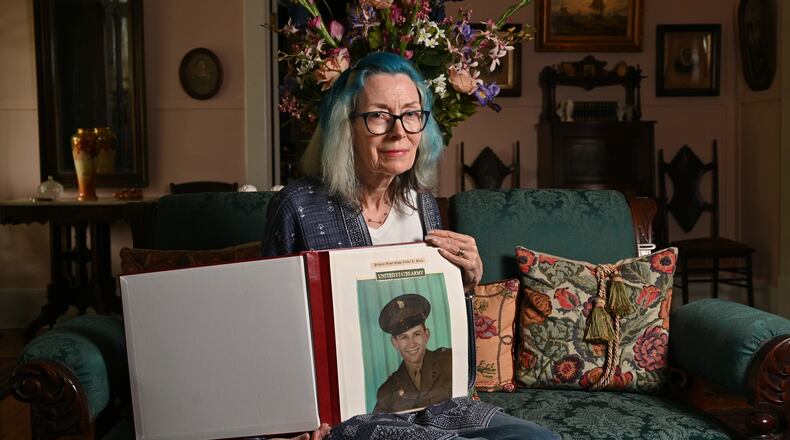Americus — The citation for the Medal of Honor Luther Story posthumously received for his heroism during the Korean War reads like something out of a novel.
As his infantry unit faced being overrun in South Korea in 1950, the teenage soldier from Buena Vista grabbed a machine gun from a wounded comrade and fired on the enemy troops advancing toward them, killing or wounding an estimated 100. Spotting a truck loaded with more enemy troops, Story fearlessly stood in the middle of the road, throwing grenades into it.
Story, who was wounded in the firefight, realized his injuries would hamper his comrades as they withdrew to a rice field. So he stayed behind to cover them. When he was last seen alive, Story was “firing every weapon available and fighting off another hostile assault.”
For 73 years, Story was unaccounted for until U.S. military officials identified his remains based on DNA, dental and anthropological analyses. First buried as an unknown soldier at the National Memorial Cemetery of the Pacific in Honolulu, Story will be reinterred with military honors at Andersonville National Cemetery during a public ceremony at 2 p.m. on Memorial Day.
Credit: Courtesy of Aldridge Funeral Services
Credit: Courtesy of Aldridge Funeral Services
Judy Wade, a niece who was born four years after Story was killed in combat, remembers reading a postcard Story sent his mother from the war.
“He said they had been on patrol and he had to shoot someone, not kill him, but shoot him — the enemy. And he didn’t know if he would ever get used to shooting a human being,” said Wade, who submitted DNA samples from her family for the military’s analysis of Story’s remains.
“To me, God gave him the strength to take care of what he needed to take care of and then took him home because he knew that wasn’t something he could do over a long period of time.”
The son of sharecroppers, Story grew up during the Great Depression in Southwest Georgia. The family farmed on land owned by former President Jimmy Carter’s father in Sumter County, Wade said.
The former president, now in hospice care, was thrilled to learn Story’s remains have finally been identified, said Jill Stuckey, superintendent of the Jimmy Carter National Historical Park.
“He remembered Luther, and he was happy that Luther was coming home,” Stuckey said.
Wade has a scrapbook created by her mother that says Story was a fun-loving child who worked as paperboy and had a good baseball pitching arm. He looked up to older relatives who served in the U.S. military and dreamed of becoming a soldier like them.
Story left high school to enlist in the U.S. Army on Oct. 21 of 1948. He completed basic training at Fort Jackson in South Carolina before he was deployed with the 9th Infantry to South Korea in the summer of 1950. On Sept. 20 of that year, the U.S. Army sent Story’s mother a telegram, telling her that her son was missing in action.
Credit: HYOSUB SHIN / AJC
Credit: HYOSUB SHIN / AJC
There is a discrepancy about how old he was at the time. His military records list his birth date as July 20, 1931, indicating he would have been 19. But Wade said her uncle’s birth certificate shows he was born a year later in 1932, meaning he would have been 18.
His grieving mother, Wade said, “got in touch with everybody she could think of in the government. If she could get someone’s name, she got in touch with them because she wanted to know where he was when he went missing. Was he alive? Did they find his body?”
On May 15 of the following year, the Army sent Story’s mother another telegram, informing her that he had been killed in action. 1st Sgt. Francis J. Tucciarone, who served as Story’s platoon sergeant and witnessed his heroic actions in the battle, told the military Story saved about 50 of his comrades. Tucciarone wrote Story’s mother about his bravery, telling her he was a “model soldier.”
“Believe me when I sincerely say my greatest wish is for my 7-year-old son to grow up to be half the man your son was,” Tucciarone wrote.
Gen. Omar Bradley presented the Medal of Honor, the nation’s highest military award for valor, to Story’s family at the Pentagon in 1951. He was survived by his parents, a brother and a sister. Story was also posthumously promoted from private first class to corporal and awarded a Purple Heart.
Credit: HYOSUB SHIN / AJC
Credit: HYOSUB SHIN / AJC
Wade was ecstatic when the federal government notified her last month that Story’s remains had finally be identified.
“I went into the beauty parlor and I said, ‘I’ve got to a have a hug. Somebody has got to hug me. I need a hug. I need a hug real bad,’” she recalled. “And so they hugged me. And they said, ‘What is going on?’ And I told them my uncle had been found and he is coming home. And they were all so happy. People who didn’t even know him and had no clue that I had a relative who was missing were just so happy for me.”
Last month, Wade traveled to the Korean War Veterans Memorial in Washington and met with President Joe Biden and South Korea President Yoon Suk Yeol. South Korean government officials gratefully presented Wade with a box of soil from where Story’s remains were initially buried in their homeland.
“Everybody that we came in contact with in Washington — they were like family,” Wade said.
The White House and the South Korean government issued a joint statement about Story’s heroism, saying: “The supreme sacrifice and heroism of Corporal Luther Story is illustrative of the freedom, security, and prosperity the South Korean people have today.”
Today, several Georgia communities claim Story. For example, a bridge spanning Kinchafoonee Creek in Marion County, where Story was born, is named after him. So is a bridge that crosses the Flint River between Sumter and Dooly counties. And his name and photo are featured on a monument to war veterans next to the Sumter Courthouse in Americus.
Americus Mayor Lee Kinnamon found Story’s baby-faced sophomore photo in the 1947 Americus High School yearbook opposite the page carrying a photo of Kinnamon’s mother. The mayor was struck by how Story is not in the school’s 1948 and 1949 yearbooks.
Credit: HYOSUB SHIN / AJC
Credit: HYOSUB SHIN / AJC
“Momma got the benefit of going through and graduating and going on to college and living a good, healthy long life. Luther didn’t,” said Kinnamon, a retired history schoolteacher.
“When I went through this yesterday and parsed all of this out, it hit me very hard what the sacrifice actually represents,” the mayor added. “This is a story of really humble origins to becoming a national hero.”
About 12 miles north of Americus stands a cenotaph dedicated to Story in Andersonville National Cemetery. He is a reminder of the sacrifices American troops and their allies made during the Korean War, said Fred Boyles, the former superintendent of Andersonville National Historic Site.
“Luther Story’s supreme sacrifice became an important part of how we continue to keep peace and stability on the Korean peninsula,” said Boyles, a U.S. Navy veteran who was deployed to South Korea.
Credit: HYOSUB SHIN / AJC
Credit: HYOSUB SHIN / AJC
The cemetery is the final resting place of one other Medal of Honor recipient, 1st Sgt. James Wiley, who fought at the Battle of Gettysburg in July of 1863. On the second day of the battle, Wiley captured the 48th Georgia Infantry Regiment’s flag. The following year, Confederate forces captured him near Petersburg, Virginia.
Wiley was held captive at Camp Sumter, commonly known as Andersonville, where he was among nearly 13,000 Union prisoners who died from disease, poor sanitation, malnutrition, overcrowding or exposure.
Meanwhile, the cemetery is preparing for a large turnout for the Memorial Day ceremony honoring Story, said Gia Wagner, the superintendent of Andersonville National Historic Site.
“We are all crying and have goosebumps from this story,” Wagner said. “With over 20,000 burials that we have, he will be our second Medal of Honor recipient. It is very rare. We are just thrilled to be chosen.”
Credit: HYOSUB SHIN / AJC
Credit: HYOSUB SHIN / AJC
About the Author
Keep Reading
The Latest
Featured










